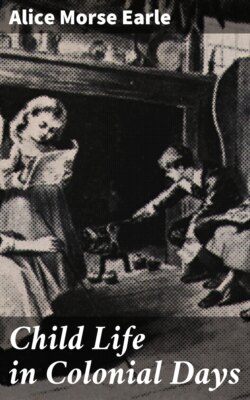Читать книгу Child Life in Colonial Days - Alice Morse Earle - Страница 6
CHILDREN'S DRESS
ОглавлениеMan's earthly Interests are all hooked and buttoned together and held up by Clothes.
—Sartor Resartus. Thomas Carlyle, 1833.
Of the dress of infants of colonial times we can judge from the articles of clothing which have been preserved till this day. Perhaps I should say that we can judge of the better garments worn by babies, not their everyday dress; for it is not their simpler attire that has survived, but their christening robes, their finer shirts and petticoats and caps.
Linen formed the chilling substructure of their dress, thin linen, low-necked, short-sleeved shirts; and linen even formed the underwear of infants until the middle of this century. These little linen shirts are daintier than the warmest silk or fine woollen underwear that have succeeded them; they are edged with fine narrow thread lace, hemstitched with tiny rows of stitches, and sometimes embroidered by hand. I have seen a little shirt and a cap embroidered with the coat of arms of the Lux and Johnson families and the motto, "God bless the Babe;" these delicate garments were worn in infancy by the Revolutionary soldier, Governor Johnson of Virginia.
Baptismal Shirt and Mittens of Governor Bradford, 1590
In the Essex Institute in Salem, Massachusetts, are the baptismal shirt and mittens of the Pilgrim Father, William Bradford, second governor of the Plymouth Colony, who was born in 1590. All are of firm, close-woven, homespun linen, but the little mittens have been worn at the ends by the active friction of baby hands, and are patched with colored "chiney" or calico. A similar colored material frills the sleeves and neck. A pair of baby's mitts of fine lace also may be seen at the Essex Institute. These were wrought in the sixteenth century, and the stitches and work are those of the antique Flanders laces. I have seen many tiny mitts knit of silk and mittens of fine linen, hemstitched, worked in drawn work or embroidered, and edged with thread-lace, and also a few mitts of yellow nankeen which must have proved specially irritating to the tiny little hands that wore them.
I have never seen a woollen petticoat that was worn by an infant of pre-Revolutionary days. It may be argued that woollen garments, being liable to ruin by moths, would naturally not be treasured. This argument scarcely is one of force, because I have been shown infants' cloaks of wool as well as woollen garments for older folk, that have been successfully preserved; also beautifully embroidered long cloaks of chamois skin. I think infants wore no woollen petticoats; their shirts, petticoats, and gowns were of linen or some cotton stuff like dimity. Warmth of clothing was given by tiny shawls pinned round the shoulders, and heavier blankets and quilts and shawls in which baby and petticoats were wholly enveloped.
Robert Gibbs, Four and a Half Years Old, 1670
The baby dresses of olden times are either rather shapeless sacques drawn in at the neck with narrow cotton ferret or linen bobbin, or little straight-waisted gowns of state. All were exquisitely made by hand, and usually of fine stuff. But the babies in pioneer settlements a century ago had to share in wearing homespun. It is told of one in a log cabin in a New Hampshire clearing that when the grandmother rode out eighty miles on horseback to see her son's first baby, she shed bitter tears at beholding the child, but a few months old, clad in a gray woollen homespun slip with an apron or tier of blue and white checked linen. The mother, a frontier lass, dressed the infant according to the fashions she was accustomed to.
Nothing could show so fully the costume of children in olden times as their portraits, and a series of such portraits of successive dates will be given in these pages. Many of them are asserted to be by the three well-known artists of colonial days,—Blackburn, Smibert, and Copley; a few are by Peale, Trumbull, and Stuart. I have accepted all family traditions as true, and in many cases believe them to be true, especially since there were few painters of any rank in the community, and no others who could paint portraits such as those which have been preserved. The Gilbert Stuarts and Trumbulls usually have some authentic pedigree. Many of these pictures have no artist's signature and are absolutely valueless as works of art, and probably meritless as likenesses; but as records of costume they are always of interest and historical worth.
There is a certain sweetness in some of these old-time portraits; they are stiff and flat, but some of them have a quaintness that reminds me of the angels of the early Florentine painters. They have little grace of figure, but the details of costume make them pleasing even if they are not beautiful.
The first child's portrait in this series is one of extraordinary interest. It is opposite page 4, and has never before been given to the public. It is the reputed miniature of the Pilgrim Father, Governor Edward Winslow, when a boy about six years of age, which would be in 1602; it is the only miniature in existence of any of the Pilgrims at any age. I have, in deference to the wishes of the Rev. Dr. William Copley Winslow of Boston (to whom I am indebted for it), entitled it the reputed miniature of the child Edward Winslow, though the term expresses neither his belief nor mine; and seems scarcely just to a portrait whose claims to authenticity are far more definite than those of many of the family portraits that have descended to us.
